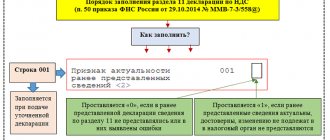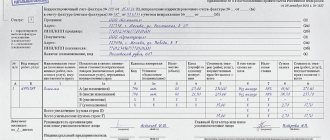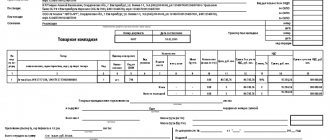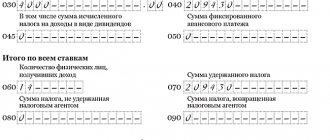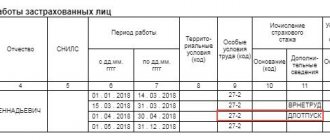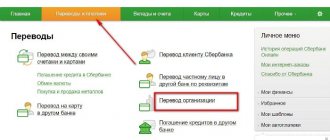An invoice is one of the most important documents used when supplying goods or providing services. The fact is that a VAT deduction is provided only on the basis of an invoice, and filling it out incorrectly will lead to the fact that the deduction will not be provided. Namely, an error in filling out the details for the sender or recipient of goods is a very common defect that occurs in practice.
Let’s figure out what requirements must be observed here in accordance with current legislation.
Dear readers! Our articles talk about typical ways to resolve legal issues, but each case is unique.
If you want to find out how to solve your particular problem, please use the online consultant form on the right or call. It's fast and free!
Invoice for services (shipper and consignee)
In accordance with the Rules, if the seller and the shipper are the same person, then in line 3 “The shipper and his address” is written “the same person” (letter of the Ministry of Finance of Russia dated October 15, 2008 No. 03-07-09/32). Note! This rule does not apply to filling out lines regarding information about the buyer, who is also the consignee. In this case, when selling goods, line 4 of the invoice indicates the full or abbreviated name of the consignee in accordance with the constituent documents and his postal address, and line 6 indicates the full or abbreviated name of the buyer in accordance with the constituent documents. Even if the buyer and consignee are the same person, writing “same” on line 4 will almost certainly lead to a dispute with the tax authority.
Invoice for services. sample
The wording “aka” is not provided for by the resolution.
- If there are two or more consignees, the names and addresses of each are indicated separated by a semicolon.
- filling out invoices Common mistakes One of the common mistakes when filling out invoices is the situation when, when issuing a document relating to the delivery of goods and provision, both the “Consignee” and “Consignee” are forgotten to fill out.
In this case, the Federal Tax Service Inspectorate, having examined the document, may declare that all details are not indicated - and, accordingly, there will be no tax deduction. Another, smaller error is the incorrectly specified name of one of the parties. The rules require that names be written in the same way as in the statutory documents. However, if the error is minor and allows the party to be identified, a deduction will be granted.
How to fill out the lines correctly?
If it concerns the shipper. According to the rules established by the current edition of Resolution No. 1137, the lines relating to the shipper are filled in as follows:
- The full name is indicated, but an abbreviation is also allowed.
- The address is indicated according to the Unified State Register of Legal Entities.
- If he and the seller are one person, then, according to paragraphs. “e” clause 1 of section I of the resolution, in the corresponding line you can write “he”. If the sender of the goods is not the seller, but another person, the mail address of the shipper is indicated. Finally, if the invoice is issued under an agreement relating not to goods, but to services or work, nothing is written on the line - a dash is placed.
- If the document is issued by an agent acting on his own behalf, but purchasing goods from two or more sellers, in the line “Consignor” all of them are indicated, but separated by a semicolon.
Now about situations when we fill out lines about the consignee. Resolution No. 1137 for the consignee establishes similar standards:
- The name is indicated - full or abbreviated.
- The address according to the Register is indicated.
- If the invoice is for services, a dash is placed in the column concerning the recipient of the cargo. The wording “aka” is not provided for by the resolution.
- If there are two or more consignees, the names and addresses of each are indicated separated by a semicolon.
What address should I put on the invoice?
Info
A tax refund will be refused if it is impossible to accurately identify the services declared by the contractor. Services must not only be named, there must be an indication of a document defining the procedure for providing, performing or delivering these services. The detail must be sufficient to correctly determine the type of services and their nature.
Examples of wording for service names:
- repair work according to act No. 12 dated 09/01/2016;
- accounting support services under agreement No. 1 dated 02/01/2016;
- services for marketing research of the building materials market for April – June 2021.
Rate the quality of the article.
Accounting and legal services
Important
But the absence of a full address according to the Unified State Register of Legal Entities is a significant error, which may become a reason for refusal to deduct. If representatives of one party to the transaction are different organizations. Situations are possible when one person acts as a supplier, but in reality the cargo is sent from the warehouse of another. This occurs, in particular, during transit deliveries, when the goods are sent to the recipient without registration at the warehouse of the intermediary seller.
In this case, in fact, there are not two, but three parties involved in the transaction:
- supplier (seller);
- sender of the cargo;
- buyer-consignee.
In the event that the shipper and the seller do not coincide with each other, this fact must be reflected in the invoice indicating the name, address and details of each of them. Lack of data may result in the tax deduction not being provided.
IP.
- Legal address of the organization.
- TIN and checkpoint. If the organization is a tax agent (for example, it is a separate division of the checkpoint) (clause 2 of Article 161 of the Tax Code of the Russian Federation), then a dash is placed in the column instead of the data.
- IMPORTANT: In 2021, the procedure for indicating the address has undergone changes!
Previously, this column was filled out in accordance with the Charter for a legal entity. Now it is filled out according to the Unified State Register of Legal Entities (or according to the Unified State Register of Individual Entrepreneurs). This means that now the address must be indicated in detail: if the Charter allows only the indication of a locality, then complete data is entered into the Register - right down to the office number. When is it necessary to write details? The specifics of filling out an invoice depend on the specific agreements under which it is used. The fact is that we can talk about the consignor and the consignee only in the case when the actual transfer of goods (cargo) takes place under the contract.
What information does the column contain?
The invoice form itself and the rules regarding the procedure for filling it out were approved by Resolution No. 1137, issued by the Government of the Russian Federation in 2011. Section I of this regulatory act is devoted specifically to the invoice.
He indicates that the document must contain a number of information, starting from the date of preparation and number, ending with the identifier of the government contract (if the invoice is used in the field of government procurement). Specifically about the sender and recipient of the cargo, the document indicates the following information:
- Name indicating the form (JSC, LLC, etc.) for organizations, name - for individual entrepreneurs.
- Legal address of the organization.
- TIN and checkpoint. If the organization is a tax agent (for example, it is a separate division of the checkpoint) (clause 2 of Article 161 of the Tax Code of the Russian Federation), then a dash is placed in the column instead of the data.
IMPORTANT: In 2021, the procedure for indicating the address has undergone changes!
Previously, this column was filled out in accordance with the Charter for a legal entity. Now it is filled out according to the Unified State Register of Legal Entities (or according to the Unified State Register of Entrepreneurs for individual entrepreneurs). This means that now the address must be indicated in detail: if the Charter allows only the indication of a locality, then complete data is entered into the Register - right down to the office number.
Consignee details on the invoice for services
When delivering a completed service subject to VAT to the customer, the contractor is obliged to prepare an invoice in the form established by Resolution 1137. This Resolution was prepared by the Government of the Russian Federation and contains standard invoice forms (initial and adjustment), as well as registers intended for their accounting. Why do the contractor and the customer need an invoice? Both parties need an invoice, so the contractor prepares it in two copies with the same content. The contractor enters the prepared document into the Sales Book using a registration entry, during which the details and indicators are transferred from the sales register to the columns of the Book. In the future, this information will be useful when preparing a VAT return and calculating the final amount of added tax to be transferred for the quarter. The shipper can be not only the seller (owner, proprietor) of the cargo, but also another person (a person who has a warehouse and acts as a shipper on behalf of the owner of the goods, or a person performing actions on his own behalf, but at the expense and on behalf of the owner of the goods). If the seller of goods under the contract is one person, and these goods are shipped from the warehouse of another person, then line 3 “Consignor and his address” indicates the full or abbreviated name of the organization from whose warehouse the goods were shipped, and his postal address (letter Ministry of Finance of Russia dated November 13, 2008 No. 03-07-09/38). The consignee can also be not only the buyer himself, but also another person authorized by the buyer to receive the cargo. If the consignee is another person, then his details must be indicated in the line “Consignee and his address.”
When performing work (providing services), there are no “consignee” as such, so the corresponding lines in the invoice are either not filled in at all, or dashes are placed in them. Today, this rule is fixed directly in Appendix No. 1 to the Rules for maintaining purchase books and sales books The unit of measurement and its OKEI code for services must be filled out while the following conditions are met:
- The price in the contract is stated per unit of measurement, and not the total price for the entire service;
- This unit of measurement is included in the corresponding classifier (first or second sections).
In other situations, dashes are placed in the columns. 3 Quantity, volume – if there are dashes in columns 2 and 2a, then they are placed in this field. Otherwise, the number of services is indicated in accordance with the specified unit of measurement. 4 Price per unit – is entered if this price is specified in the contract and columns 2 and 2a of the invoice table are completed. Otherwise, the columns are crossed out. 5 Total cost for each item as a whole, tax is not included in this cost. 6 The wording “without excise duty” is written.
In what cases are the lines Consignor and Consignee filled in in invoices?
If representatives of one party to the transaction are different organizations
In the event that the shipper and the seller do not coincide with each other, this fact must be reflected in the invoice indicating the name, address and details of each of them. Lack of data may result in the tax deduction not being provided.
IMPORTANT: Transactions are also possible where the buyer and consignee do not match. In this case, complete data must also be provided for each of them.
Now you know what to do in situations where the seller and the shipper are different legal entities. The same applies to cases where the buyer and consignee are different organizations.
Source: ICG "IC Group"
An invoice is a document giving the right to deduct VAT. Incorrect execution or absence of any of the required invoice details may deprive you of the deduction.
Filling out information about the shipper and consignee requires special attention, since tax authorities often refuse deductions due to incorrect execution of these particular lines of the invoice.
When performing work (provision) and the “consignee” are absent as such, therefore the corresponding lines in the invoice are either not filled in at all, or dashes are placed in them.
Today, this rule is recorded directly in Appendix No. 1 to the Rules for maintaining purchase books and sales books. It appeared in this Appendix only in 2009 (corresponding changes were made to the Rules for maintaining purchase books and sales books by Decree of the Government of the Russian Federation of May 26, 2009 No. 451).
However, the Ministry of Finance of Russia and the tax authorities adhered to this position before (see letters of the Ministry of Finance of Russia dated January 22, 2009 No. 03-07-09/03, dated May 12, 2008 No. 03-07-11/186, Federal Tax Service of Russia for Moscow dated 04/24/2007 No. 19-11/37426). If these lines are nevertheless filled in, then this cannot be a reason for refusing to deduct VAT. After all, the presence in the invoice of additional information, in addition to the mandatory details, cannot serve as a basis for refusing to deduct VAT (see letter of the Ministry of Finance of Russia dated April 24, 2006 No. 03-04-09/07).
When selling goods, information about the consignor and consignee must be included in the invoice.
In accordance with the Rules, if the seller and the shipper are the same person, then in line 3 “The shipper and his address” is written “the same person” (letter of the Ministry of Finance of Russia dated October 15, 2008 No. 03-07-09/32).
Note! This rule does not apply to filling out lines regarding information about the buyer, who is also the consignee. In this case, when selling goods, line 4 of the invoice indicates the full or abbreviated name of the consignee in accordance with the constituent documents and his postal address, and line 6 indicates the full or abbreviated name of the buyer in accordance with the constituent documents. Even if the buyer and consignee are the same person, writing “same” on line 4 will almost certainly lead to a dispute with the tax authority.
The letter of the Ministry of Finance of Russia dated July 21, 2008 No. 03-07-09/21 states that invoices, in line 4 “Consignee and his address” which contain the words “he” cannot be the basis for the acceptance of amounts presented to the buyer by the seller value added tax deductible or refundable.
At the same time, we will make a reservation that when considering a case in court, a decision in such a situation will most likely be made in favor of the taxpayer. The courts do not consider the entry “he” in the line “Consignee and his address” to be a violation of the procedure for issuing invoices in the event that the buyer and the consignee are actually the same person (provided that all the buyer’s details are indicated on the invoice) ( see, for example, resolutions of the Federal Antimonopoly Service of the Far Eastern District dated January 31, 2007 No. F03-A73/06-2/5357, Volga District dated October 2, 2007 No. A72-6677/06-12/228, Northwestern District dated April 10, 2007 No. A56-21994/2006, East Siberian District dated 06.06.2006 No. A19-38799/05-52-F02-2084/06-S1, A19-38799/05-52-F02-2709/06-S1, Central District dated 07/17/2008 No. A48-4502/07-6).
The shipper can be not only the seller (owner, proprietor) of the cargo, but also another person (a person who has a warehouse and acts as a shipper on behalf of the owner of the goods, or a person performing actions on his own behalf, but at the expense and on behalf of the owner of the goods).
If the seller of goods under the contract is one person, and these goods are shipped from the warehouse of another person, then line 3 “Consignor and his address” indicates the full or abbreviated name of the organization from whose warehouse the goods were shipped, and his postal address (letter Ministry of Finance of Russia dated November 13, 2008 No. 03-07-09/38).
The consignee can also be not only the buyer himself, but also another person authorized by the buyer to receive the cargo. If the consignee is another person, then his details must be indicated in the line “Consignee and his address.” The corresponding clarifications are given in the letter of the Federal Tax Service of Russia dated December 25, 2006 No. 03-1-03/ [email protected] Information about the consignor and consignee must comply with the terms of the contract for the supply of goods (letter of the Federal Tax Service of Russia for Moscow dated January 23, 2008 No. 19-11/ 005123) and, accordingly, must coincide with similar information specified in the shipping documents. If there is a discrepancy, the dispute with the tax office will most likely have to be resolved in court. Of course, there is a chance of winning such a dispute in court.
For example, the Supreme Arbitration Court of the Russian Federation agreed that if in the invoice the supplier indicated himself as the shipper, and not the person named as the shipper in the waybills, then this is not a violation of the requirements of Article 169 of the Tax Code of the Russian Federation (Determination of the Supreme Arbitration Court of the Russian Federation dated December 21, 2007 No. 17236/07).
The Federal Antimonopoly Service of the Far Eastern District made a decision in favor of the taxpayer in a situation where the taxpayer-buyer was named as the consignee in the invoice, while other persons were listed as consignees in the acceptance certificates. Since the taxpayer-buyer presented a contract confirming the existence of a relationship between him and the actual consignees, the court recognized the inspection’s refusal to reimburse VAT due to incorrect indication of the consignee in the invoice as formal and inconsistent with the Tax Code (Resolution dated October 24, 2007 No. F03-A04/07- 2/3613).
But, of course, you cannot count on all judges to be so loyal. Depending on the specific circumstances, the court decision may be unfavorable for the taxpayer (Resolution of the Federal Antimonopoly Service of the East Siberian District dated 06.06.2006 No. A19-4522/05-40-41-F02-2657/06-S1).
Based on materials from the book “VAT 2009: deductions and invoices”
Consignee details on the invoice for services
For the shipment of goods, provision of services and mixed, t In what cases are the lines “Consignor” and “Consignee” filled in invoices? For shipment of goods, provision of services and mixed. those. goods and services in one invoice. And how does this violation affect the deduction of VAT? Fill in lines 3 “Consignor and his address” and 4 “Consignee and his address” only when selling goods. When drawing up an invoice for work performed (services rendered), lines 3 and 4 must be filled with a dash.
When issuing one invoice for goods shipped and work performed (services rendered), it is necessary to fill out line 3 “Consignor and his address” and line 4 “Consignee and his address.”
